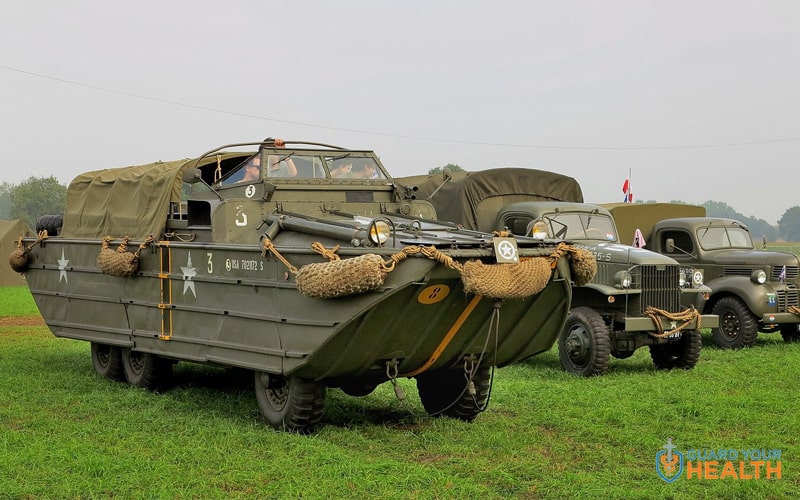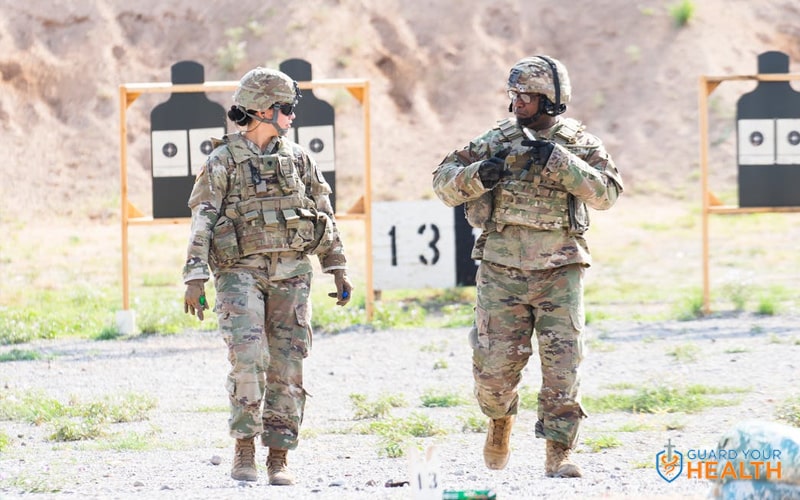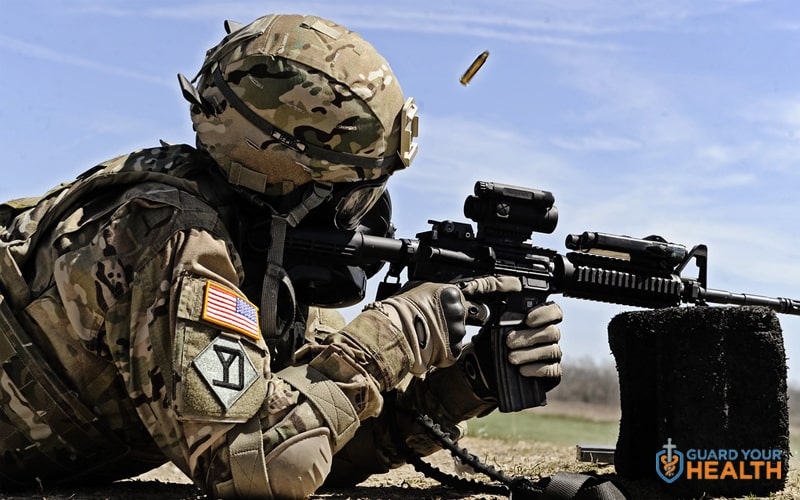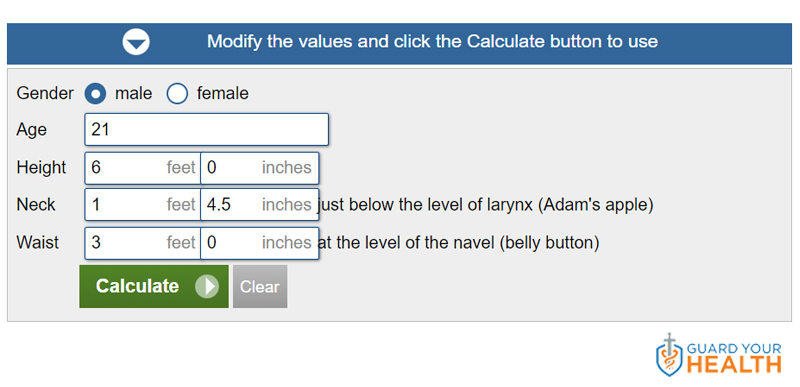Many people don’t know height and weight are criteria in the recruitment. They wonder if their physical conditions can pass this strict qualification. This post will discuss army height and weight standards to give you a more detailed look into this topic. The information in this post is devoted to young people attempting to enroll in the US Army.
You will know what needs to be changed and preparations to be made before making the decision. Scroll down to read the details!

How Are Army Height And Weight Standards Measured?
Army officers will conduct the tape tests on your body at the enrollment site to take official height and weight. They will tape around the neck and the abdomen three times for males.
The final record is the average of the figures taken in the three tape tests. The measurements will be circular up or down to the nearest figure regarding a half-inch difference.
Similarly, the official weight measurements will be rounded up or down to the nearest pound with less than a half-pound difference. For example, if you weigh 176.4 pounds, the official number recorded will be 176 pounds.
Candidates who pass this qualification will go on to take the body fat percentage tests. It is the final challenge before you are successfully enlisted.
If you fail this height and weight test, the officers will flag your record. It means that you cannot access promotions or army education institutions until you pass the height and weight standards.
Soldier Requirements
Here are some basic criteria that candidates must surpass to become an official recruit in the US Army. These requirements ensure that the soldiers can cope with the intense working schedules and handle heavy tasks in the Army.
Height Requirements
There is an accepted height range in the US Army with absolutely no exceptions. If your height doesn’t fall within this range, you cannot qualify for the Army service.
The allowed height range for males is from 58 inches (147,32 centimeters) to 80 inches (203,2 centimeters). Candidates who are either too tall or too short won’t be allowed to join the Army.
The same height standard applies to female candidates. Yet, the maximum height for marine soldiers is only 78 inches (male) and 72 inches (women).
The reason behind this strict requirement is that the height standards enable soldiers to operate the basic duties in the Army. One popular example is driving Army vehicles such as trucks, tanks, or even working on airplanes.
There is no extra uniform and equipment suitable for people who don’t meet the height requirements. The Army simply doesn’t have enough time and budget to provide these special items.

Weight Requirements
The allowed weight range for US soldiers will vary in different age groups and genders. Weight requirements are less strict for older soldiers.
Also, your weight must correspond with your average height. For example, if you are 60 inches tall, you must exceed a minimum weight of 97 pounds.
The minimum and maximum weight allowed will increase when you get older.
This restriction ensures that soldiers maintain their disciplined lifestyle and keep their bodies fit through strict diets and hard training sessions.
Growth Allowance
There is a special rule that allows you to continue serving in the Army if your body’s height grows beyond the height limits.
The establishment of this rule is understandable since the minimum age allowed to apply for the Army is 17, with the consensus of candidates’ parents.
These young applicants are still in the developing process, and their physical conditions can grow in the years ahead.
Once you have passed the tests and qualifications, no one has the right to disband you for over body height. However, it may hinder your career as you cannot access future exams with height restrictions.
U.S. Army Height And Weight Standards By Age
Here are the table charts featuring US Army height and weight standards for both genders. You can do your own tape measure to figure out if you can pass the qualification test.
Chart for Male
| Height
(inches) |
Mini Weight
(Pounds) |
Max Weight (17-20) | Max Weight
(21-27) |
Max Weight
(28-39) |
Max Weight
(Over 40) |
| 58 | 91 | ||||
| 59 | 94 | ||||
| 60 | 97 | 132 | 136 | 139 | 141 |
| 61 | 100 | 136 | 140 | 144 | 146 |
| 62 | 104 | 141 | 144 | 148 | 150 |
| 63 | 107 | 145 | 149 | 153 | 155 |
| 64 | 110 | 150 | 154 | 158 | 160 |
| 65 | 114 | 155 | 159 | 163 | 165 |
| 66 | 117 | 160 | 163 | 168 | 170 |
| 67 | 121 | 165 | 169 | 174 | 176 |
| 68 | 125 | 170 | 174 | 179 | 181 |
| 69 | 128 | 175 | 179 | 184 | 186 |
| 70 | 132 | 180 | 185 | 189 | 192 |
| 71 | 136 | 185 | 189 | 194 | 197 |
| 72 | 140 | 190 | 195 | 200 | 203 |
| 73 | 144 | 195 | 200 | 205 | 208 |
| 74 | 148 | 201 | 206 | 211 | 214 |
| 75 | 152 | 206 | 212 | 217 | 220 |
| 76 | 156 | 212 | 217 | 223 | 226 |
| 77 | 160 | 218 | 223 | 229 | 232 |
| 78 | 164 | 223 | 229 | 235 | 238 |
| 79 | 168 | 229 | 235 | 241 | 244 |
| 80 | 173 | 234 | 240 | 247 | 250 |
Chart for Female
| Height
(inches) |
Mini Weight
(Pounds) |
Max Weight (17-20) | Max Weight
(21-27) |
Max Weight
(28-39) |
Max Weight
(Over 40) |
| 58 | 91 | 119 | 121 | 122 | 124 |
| 59 | 94 | 124 | 125 | 126 | 128 |
| 60 | 97 | 128 | 129 | 131 | 133 |
| 61 | 100 | 132 | 134 | 135 | 137 |
| 62 | 104 | 136 | 138 | 140 | 142 |
| 63 | 107 | 141 | 143 | 144 | 146 |
| 64 | 110 | 145 | 147 | 149 | 151 |
| 65 | 114 | 150 | 152 | 154 | 156 |
| 66 | 117 | 155 | 156 | 158 | 161 |
| 67 | 121 | 159 | 161 | 163 | 166 |
| 68 | 125 | 164 | 166 | 168 | 171 |
| 69 | 128 | 169 | 171 | 173 | 176 |
| 70 | 132 | 174 | 176 | 178 | 181 |
| 71 | 136 | 179 | 181 | 183 | 186 |
| 72 | 140 | 184 | 186 | 188 | 191 |
| 73 | 144 | 189 | 191 | 194 | 197 |
| 74 | 148 | 194 | 197 | 199 | 202 |
| 75 | 152 | 200 | 202 | 204 | 208 |
| 76 | 156 | 205 | 207 | 210 | 213 |
| 77 | 160 | 210 | 213 | 215 | 219 |
| 78 | 164 | 216 | 218 | 221 | 225 |
| 79 | 168 | 221 | 224 | 227 | 230 |
| 80 | 173 | 227 | 230 | 233 | 236 |
You can use Army Body Fat Calculator. This calculator computes body fat percentage based on methods in the U.S. Army’s Standards of Medical Fitness and its army recruitment compliance category.
How To Meet Army Height And Weight Standards?
A healthy and fit body shape allows soldiers to cope with harsh circumstances and training sessions. These are some basic guidelines you should know before enrolling in the US military.
Composition Rule
The percentage of your body fat is determined based on your body composition. In other words, body composition can determine your level of health, which is an important factor in the military.
Officers calculate body composition based on at least three measurements: Height, neck size, and waist size.
The maximum allowed body composition for male is 24% (17-20), 26% (21-27), 28% (28-39) and 30% (over 40). The figures for women are 6 percent higher in each category.
There will be regular composition tests to check a soldier’s body fat percentage when serving in the military. The demands are stricter for male soldiers.
Those who fail these periodical tests will receive administrative sanctions.
The Difference Between Body Fat & Body Mass
A fair judgment of one’s body fitness cannot be determined solely by body mass. Body mass is more popular for assessing risks of diseases like diabetes, strokes, and cancer.
Meanwhile, body fat tells the proportion between your fat and muscles. Thereby body fat can produce a more accurate measurement of fitness and is used widely in military qualification exams.
One downside of body fat is that we do not yet have the right measuring method with absolute accuracy. The available methods used in the military can produce unequal results on different attempts.
What Should You Prepare For The Enrollment?
Jobs in the US military are only for determined soldiers with discipline and great aspiration. There is an amount of work to do if you really want to join the Army.
The most urgent task to do is setting up a proper workout schedule and a healthy eating diet. While we cannot do much about height, we can take control of our body weight.
Ensure that you have a detailed goal in mind. For example, your height and weight are currently 78 inches and 164 pounds. Set a goal to reduce your body mass to 160 pounds to meet the weight standard.
A professional coach can design a suitable working schedule for your physical conditions and stamina. For overweight candidates, Try to counsel doctors to adopt a healthy and nutritious eating diet.
Finally, remember to grasp all the basic procedures and requirements of the qualification tests.

Final Thoughts
We hope that the information about Army Height And Weight Standards provided in this post can help you pass the army enrollment and fulfill your dream.
Only the ones with a burning spirit and determination can become a soldier. Start working today and change your life.

The 16th Sergeant Major of the Army, Sgt. Maj Christian Smelling was sworn in on August 11th 2009 and has held every enlisted leadership position ranging from cannon crew member to command sergent major



